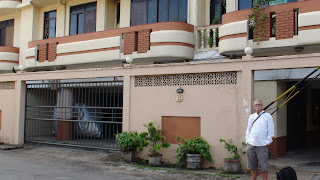We survived the Inca Trail
We made it! We survived the Inca Trail and were rewarded with the splendour that took our breathe away at the site of the Sacred City of Machu Picchu.
We and eleven other fellow hikers from New Zealand, Australia and two other Canadians from Calgary began this 44 km sojourn on April 2, leaving Cuscos by bus in the morning and staying in a homestay in Ollantaytambo after a nice dinner in this bustling tourist town.
Ollantaytambo is the site of another magnificent Inca site where huge rocks in the temple are seamed perfectly without the use of mortar. It is mind boggling to see this and to try and sort out, how on earth the Inca stone workers perfectly seamed rock. One of the rocks at Machu Picchu (MP) has 32 perfectly seamed sides!
On April 3, we began our hike from Ollantaytambo (2720 metres above sea level) and began a 7 hour trek along the "Peruvian trail" undulating along and up and down over a completely stone pathway. Ascents along the trail are facilitated by stone steps. We hiked into the forest about 7 hours that day, encountering the Inca sites of Piskacucho and Wayllambamba along the way. We were guided by two guides, Rueben and Guillermo. Rueben was a walking encyclopedia on the Inca people and was a great resource to help us understand the rise and fall of the Inca empire.
Just past Wayllanbamba (3000 m.) we arrived in camp about 6 pm that night. Our sleeping tents, sleeping bags and all the cooking equipment and food was carried by porters who flew up the mountain side with 20 kgs on their skinny backs. It was amazing to watch the porters strength and agility, many of whom had feet clad only in rough hand made sandals or cheap running shoes. Our porters ranged in age from 54 to 18 and surprizingly, the older porters can carry more than the younger porters due to their experience. The porters, now cooks and servers, fed and watered us and put us to bed.
April 4: This day was touted as the "hardest day" as it entailed an 8 hour steady ascent over the stoned pathways and contained many very steep staircases to facilitate the ascent across the highest point in altitude, Dead Woman's Pass at 4200 m. We passed and visited two Inca sites along the way and did not get lunch until about 2:30 pm that day. We had lunch and dinner in the same campsite. We all breathed a sigh of relief that we had managed the demands of the difficult day. We crashed under the incredible stars of our Milky Way.
April 5: At 7:30 we hit the trail for the "longest day" of the trail and over the second highest pass, Runkurakay Pass at 3,950 m. It was the longest day as once over the pass, we had another high pass and hours of very steep downhill steps to camp, that required us to slowly pick our way down the steps and through tunnels into the campsite. Darkness descended upon us whilst still deep in the jungle and before we reached camp. With the aid of our flashlights, we crawled into camp about 45 minutes after night fall. The night frogs and crickets heralded our arrival into camp. Porters had come back to find us and escorted us into the camp by a rather circuitous route. We ate and crawled into our tents, dog tired. 12 hours of trekking!
April 6: We were awakened by the porters at 3:30 am. The stars were magical as we broke camp and began the 2 hour trek to Machu Picchu. We left early in order to have some private time in the city and beat all the tourists arriving by train. Leaving early also availed us the opportunity to see the sun rise over the ancient city.
It was surreal! The dawning sunlight lit up a triangle on the mountain that shelters Machu Picchu and as the sun rose, more of the mountain was exposed filling the city with light.
I will post pictures and let the pictures describe this most ancient city. We explored the site with explanations from our guide. We were grateful to not have to walk out along the same trail, and so, the finale was taking the Machu Picchu train back to Ollayantaytambo and then the bus back to Cusco.
Bill and I had no trouble with altitude sickness. We sipped cocoa tea and chewed on cocoa leaves - as we all did. It is the local remedy. Bill handled the nickel bag of cocoa leaves for the group and was labelled the "Drug Dealer." When someone was reluctant to try the leaves, he encouraged them to give it a go. As a result, his status was upgraded to "Drug Pusher."
We had a lot of fun. Would we do it again?
No #$%* way!



Comments
Post a Comment